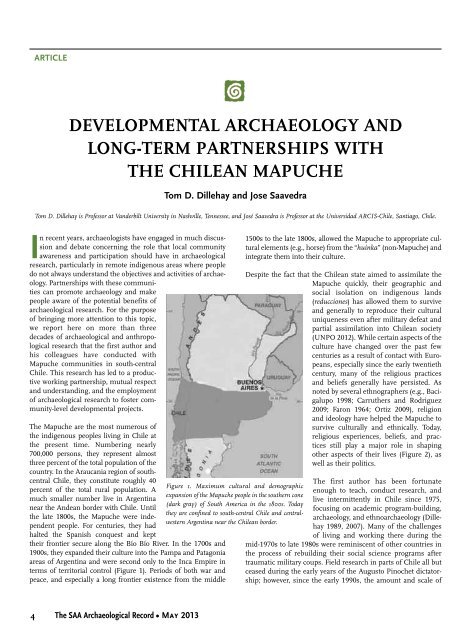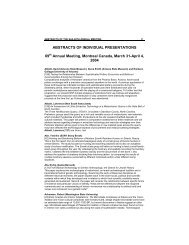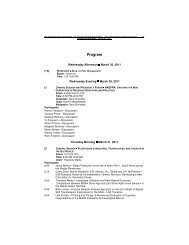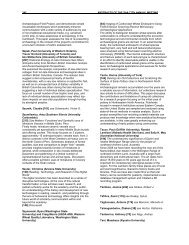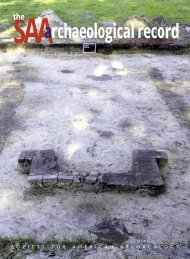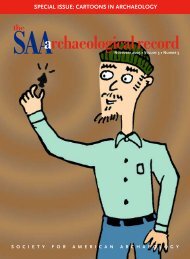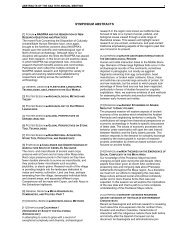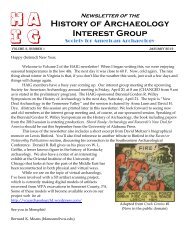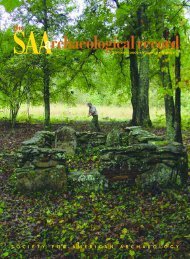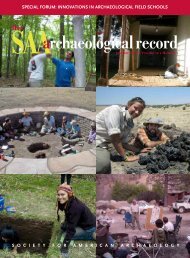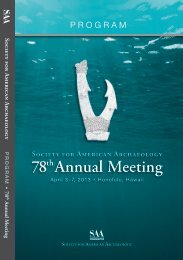The SAA Archaeological Record - Society for American Archaeology
The SAA Archaeological Record - Society for American Archaeology
The SAA Archaeological Record - Society for American Archaeology
Create successful ePaper yourself
Turn your PDF publications into a flip-book with our unique Google optimized e-Paper software.
ARTICLE<br />
DEVELOPMENTAL ARCHAEOLOGY AND<br />
LONG-TERM PARTNERSHIPS WITH<br />
THE CHILEAN MAPUCHE<br />
Tom D. Dillehay and Jose Saavedra<br />
Tom D. Dillehay is Professor at Vanderbilt University in Nashville, Tennessee, and José Saavedra is Professor at the Universidad ARCIS-Chile, Santiago, Chile.<br />
In recent years, archaeologists have engaged in much discussion<br />
and debate concerning the role that local community<br />
awareness and participation should have in archaeological<br />
research, particularly in remote indigenous areas where people<br />
do not always understand the objectives and activities of archaeology.<br />
Partnerships with these communities<br />
can promote archaeology and make<br />
people aware of the potential benefits of<br />
archaeological research. For the purpose<br />
of bringing more attention to this topic,<br />
we report here on more than three<br />
decades of archaeological and anthropological<br />
research that the first author and<br />
his colleagues have conducted with<br />
Mapuche communities in south-central<br />
Chile. This research has led to a productive<br />
working partnership, mutual respect<br />
and understanding, and the employment<br />
of archaeological research to foster community-level<br />
developmental projects.<br />
<strong>The</strong> Mapuche are the most numerous of<br />
the indigenous peoples living in Chile at<br />
the present time. Numbering nearly<br />
700,000 persons, they represent almost<br />
three percent of the total population of the<br />
country. In the Araucania region of southcentral<br />
Chile, they constitute roughly 40<br />
percent of the total rural population. A<br />
much smaller number live in Argentina<br />
near the Andean border with Chile. Until<br />
the late 1800s, the Mapuche were independent<br />
people. For centuries, they had<br />
halted the Spanish conquest and kept<br />
their frontier secure along the Bío Bío River. In the 1700s and<br />
1900s, they expanded their culture into the Pampa and Patagonia<br />
areas of Argentina and were second only to the Inca Empire in<br />
terms of territorial control (Figure 1). Periods of both war and<br />
peace, and especially a long frontier existence from the middle<br />
Figure 1. Maximum cultural and demographic<br />
expansion of the Mapuche people in the southern cone<br />
(dark gray) of South America in the 1800s. Today<br />
they are confined to south-central Chile and centralwestern<br />
Argentina near the Chilean border.<br />
1500s to the late 1800s, allowed the Mapuche to appropriate cultural<br />
elements (e.g., horse) from the “huinka” (non-Mapuche) and<br />
integrate them into their culture.<br />
Despite the fact that the Chilean state aimed to assimilate the<br />
Mapuche quickly, their geographic and<br />
social isolation on indigenous lands<br />
(reducciones) has allowed them to survive<br />
and generally to reproduce their cultural<br />
uniqueness even after military defeat and<br />
partial assimilation into Chilean society<br />
(UNPO 2012). While certain aspects of the<br />
culture have changed over the past few<br />
centuries as a result of contact with Europeans,<br />
especially since the early twentieth<br />
century, many of the religious practices<br />
and beliefs generally have persisted. As<br />
noted by several ethnographers (e.g., Bacigalupo<br />
1998; Carruthers and Rodriguez<br />
2009; Faron 1964; Ortiz 2009), religion<br />
and ideology have helped the Mapuche to<br />
survive culturally and ethnically. Today,<br />
religious experiences, beliefs, and practices<br />
still play a major role in shaping<br />
other aspects of their lives (Figure 2), as<br />
well as their politics.<br />
<strong>The</strong> first author has been <strong>for</strong>tunate<br />
enough to teach, conduct research, and<br />
live intermittently in Chile since 1975,<br />
focusing on academic program-building,<br />
archaeology, and ethnoarchaeology (Dillehay<br />
1989, 2007). Many of the challenges<br />
of living and working there during the<br />
mid-1970s to late 1980s were reminiscent of other countries in<br />
the process of rebuilding their social science programs after<br />
traumatic military coups. Field research in parts of Chile all but<br />
ceased during the early years of the Augusto Pinochet dictatorship;<br />
however, since the early 1990s, the amount and scale of<br />
4 <strong>The</strong> <strong>SAA</strong> <strong>Archaeological</strong> <strong>Record</strong> • May 2013


